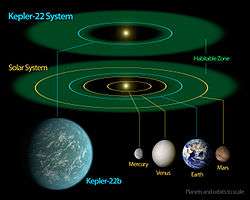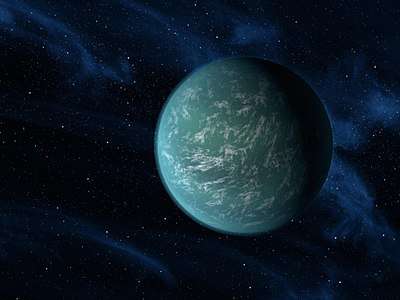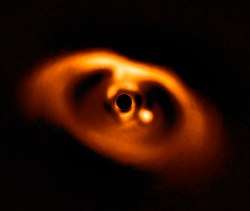Kepler-22b
Kepler-22b, also known by its Kepler object of interest designation KOI-087.01, is an extrasolar planet orbiting within the habitable zone of the Sun-like star Kepler-22. It is located about 587 light-years (180 pc) from Earth in the constellation of Cygnus. It was discovered by NASA's Kepler Space Telescope in December 2011 and was the first known transiting planet to orbit within the habitable zone of a Sun-like star, where liquid water could exist on the planet's surface.[6] Kepler-22 is too dim to be seen with the naked eye.
 A diagram of the orbit of Kepler-22b within the Kepler-22 system, as compared to the inner Solar System, and their respective projected habitable zones. | |
| Discovery | |
|---|---|
| Discovered by | Kepler Science Team |
| Discovery site | Kepler telescope |
| Discovery date | 5 December 2011 (announced) [1] |
| Transit | |
| Orbital characteristics | |
| 0.849 ± 0.018 AU (127,000,000 ± 2,700,000 km)[2] | |
| Eccentricity | 0 |
| 289.862 ± 0.02[2][3] d | |
| Inclination | 89.764 +0.042 −0.025[2] |
| Star | Kepler-22 |
| Physical characteristics | |
Mean radius | 2.4 +0.09 −0.07[4] R⊕ |
| Mass | <52.8 [5] M⊕ |
| Temperature | 295 K (22 °C; 71 °F) |
Kepler-22b's size is roughly twice that of Earth. Its mass and surface composition are unknown. An Earth-like composition for the planet has been ruled out. It is likely to have a volatile-rich composition with a liquid or gaseous outer shell. The only parameters of the planet's orbit that are currently available are its orbital period, which is about 290 days, and its inclination, which is approximately 90°. Evidence suggests that the planet has a moderate surface temperature, assuming that the surface is not subject to extreme greenhouse heating. In the absence of an atmosphere, its equilibrium temperature (assuming an Earth-like albedo) would be approximately 262 K (−11 °C), compared to Earth's 255 K (−18 °C)
The planet's first transit was observed on 12 May 2009. Confirmation of the existence of Kepler-22b was announced on 5 December 2011.
Characteristics
Kepler-22b is an extrasolar planet orbiting around the star Kepler-22.[1][7] It is about 587 light-years (180 pc) from Earth in the constellation of Cygnus. It was discovered by the Kepler Space Telescope in December 2011.[1][7][8]
Mass and radius
Kepler-22b's radius is roughly 2.4 times that of Earth.[4] Its mass and surface composition remain unknown,[1][7] with only some very rough estimates established: it has fewer than 124 Earth masses at the 3-sigma confidence limit, and fewer than 36 Earth masses at 1-sigma confidence.[9] The adopted model in Kipping et al. (2013) does not reliably detect the mass (the best fit value is only slightly larger than the 1-sigma error bar), though the mass is below 52.8 Earth masses to 95% confidence.
Kepler-22b, dubbed by scientists as a 'waterworld', might be an 'ocean-like' planet. It might also be comparable to the water-rich planet GJ 1214 b although Kepler-22b, unlike GJ 1214 b, is in the habitable zone. An Earth-like composition is ruled out to at least 1-sigma uncertainty by radial velocity measurements of the system.[9][10] It is thus likely to have a more volatile-rich composition with a liquid or gaseous outer shell;[11] this would make it similar to Kepler-11f, the smallest known gas planet. Natalie Batalha, one of the scientists on the Kepler Space Telescope project, has speculated, "If it is mostly ocean with a small rocky core, it's not beyond the realm of possibility that life could exist in such an ocean".[12] This possibility has spurred SETI to perform research on top candidates for extraterrestrial life.[13]
Host star
The host star, Kepler-22, is a G-type star that is 3% less massive than the Sun and 2% smaller in volume. It has a surface temperature of 5,518 K (5,245 °C) compared with the Sun, which has a surface temperature of 5,778 K (5,505 °C).[14] The star is about 4 billion years old.[15] In comparison, the Sun is 4.6 billion years old.[16]
The apparent magnitude of Kepler-22 is 11.5, which means it is too dim to be seen with the naked eye.
Orbit
The only parameters of the planet's orbit that are currently available are its orbital period, which is about 290 days, and its inclination, which is approximately 90°. From Earth, the planet appears to make a transit across the disk of its host star. It has an eccentricity of 0, meaning its orbit is circular.[2] In order to obtain further information about the details of the planet's orbit, other methods of planetary detection, such as the radial velocity method, need to be used. While such methods have been performed on the planet since its discovery, these methods have not yet detected an accurate value for the eccentricity of the planet and so (as of March 2012) only an upper limit for the mass of the planet has been set by astronomers.
Habitability

The average distance from Kepler-22b to its host star Kepler-22 is about 15% less than the distance from Earth to the Sun[2] but the luminosity (light output) of Kepler-22 is about 25% less than that of the Sun.[7] This combination of a shorter average distance from the star and a lower stellar luminosity are consistent with a moderate surface temperature at that distance, if it is assumed that the surface is not subject to extreme greenhouse heating.
If Kepler-22b moves in a highly elliptical orbit, as it seems, its surface temperature variance will be very high.
Climate
Scientists can estimate the possible surface conditions as follows:
- In the absence of an atmosphere, its equilibrium temperature (assuming an Earth-like albedo) would be approximately 262 K (−11 °C), compared to Earth's 255 K (−18 °C).[9]
- If the atmosphere provides a greenhouse effect similar in magnitude to the one on Earth, it would have an average surface temperature of 295 K (22 °C).[17]
- If the atmosphere has a greenhouse effect similar in magnitude to the one on Venus, it would have an average surface temperature of 733 K (460 °C).
Recent estimates suggest that Kepler-22b has more than a 95% probability of being located in the empirical habitable zone defined by the recent Venus and early Mars limits (based on estimates of when these planets may have supported habitable conditions), but less than a 5% chance of being located in the conservative habitable zone within the Circumstellar habitable zone, (estimated from a 1D cloud-free radiative-convective model).[5]
Limits on satellites
The Hunt for Exomoons with Kepler (HEK) project has studied the Kepler photometry of the planet, to find any evidence of transit timing and duration variations that may be caused by an orbiting satellite. Such variations were not found, so ruling out the existence of any satellites of Kepler-22b with a mass greater than 0.54 Earth masses.[5]
Discovery and observation
The planet's first transit in front of its host star was observed on Kepler's third day of scientific operations, on 12 May 2009.[18] The third transit was detected on 15 December 2010. Additional confirmation data was provided by the Spitzer Space Telescope and ground-based observations. Confirmation of the existence of Kepler-22b was announced on 5 December 2011.[7]
Past transit dates
| Transits of Kepler-22b | |||||
|---|---|---|---|---|---|
| Date(s) of transit[9] |
Time (UTC) | Notes | |||
| Start | Mid | End | |||
| 15 May 2009 | First observed transit by Kepler space telescope | ||||
| 1 March 2010 | Observed by Spitzer[19] | ||||
| 15 December 2010 | 3rd transit observed by Kepler | ||||
| 1 October 2011 | 7.4 hour transit observed by Spitzer space telescope, confirming the planet | ||||
See also
- Earth analog
- Gliese 163 c
- Gliese 581 d
- Gliese 581 g
- Gliese 667 Cc
- Kepler-452b
- Kepler-62f
- Kepler-1229b
- HD 85512 b
- Kepler-69c
- Kepler-186f
- PH2 b
- Planetary habitability
References
- "NASA – NASA's Kepler Confirms Its First Planet in Habitable Zone of Sun-like Star". NASA Press Release. Retrieved 6 December 2011.
- "Notes for Planet Kepler-22 b". Extrasolar Planet Database. Retrieved 6 December 2011.
- Klotz, Irene (5 December 2011). "Alien Planet Could Host Life]". Discovery.com. Archived from the original on 7 January 2012.
- "Kepler-22 b". NASA Exoplanet Archive. Retrieved 4 July 2016.
- Kipping, D. M.; Forgan, D.; Hartman, J.; Nesvorný, D.; Bakos, G. Á.; Schmitt, A.; Buchhave, L. (2013). "The Hunt for Exomoons with Kepler (Hek). Iii. The First Search for an Exomoon Around a Habitable-Zone Planet". The Astrophysical Journal. 777 (2): 134–150. arXiv:1306.1530. Bibcode:2013ApJ...777..134K. doi:10.1088/0004-637X/777/2/134.
- https://www.nasa.gov/mission_pages/kepler/news/kepscicon-briefing.html
- "Kepler 22-b: Earth-like planet confirmed". BBC Online. 5 December 2011. Retrieved 6 December 2011.
- Kepler-22b: Facts About Exoplanet in Habitable Zone
- Borucki, William J.; Koch, David G.; Batalha, Natalie; Bryson, Stephen T.; Rowe, Jason; Fressin, Francois; Torres, Guillermo; Caldwell, Douglas A.; Christensen-Dalsgaard, Jørgen; Cochran, William D.; Devore, Edna; Gautier, Thomas N.; Geary, John C.; Gilliland, Ronald; Gould, Alan; Howell, Steve B.; Jenkins, Jon M.; Latham, David W.; Lissauer, Jack J.; Marcy, Geoffrey W.; Sasselov, Dimitar; Boss, Alan; Charbonneau, David; Ciardi, David; Kaltenegger, Lisa; Doyle, Laurance; Dupree, Andrea K.; Ford, Eric B.; Fortney, Jonathan; Holman, Matthew J. (2012). "Kepler-22b: A 2.4 Earth-radius Planet in the Habitable Zone of a Sun-like Star". The Astrophysical Journal. 745 (2): 120. arXiv:1112.1640. Bibcode:2012ApJ...745..120B. doi:10.1088/0004-637X/745/2/120. The article gives Julian dates, which are converted at imcce.fr Archived 22 October 2011 at the Wayback Machine (all dates in Univ. Time)
- Scharf, Caleb A. (8 December 2011). "You Can't Always Tell An Exoplanet By Its Size". Scientific American. Retrieved 20 September 2012.: "If it [Kepler-22b] had a similar composition to the Earth, then we’re looking at a world in excess of about 40 Earth masses".
- "Most 1.6 Earth-radius planets are not rocky". 31 July 2014.
- Rincon, Paul (5 December 2011). "A home from home: Five planets that could host life". BBC News. Retrieved 26 November 2016.
- Ian O'Neill (5 December 2011). "SETI to Hunt for Aliens on Kepler's Worlds". Discovery News.
- Fraser Cain (15 September 2008). "Temperature of the Sun". Universe Today. Retrieved 19 February 2011.
- Safonova, M.; Murthy, J.; Shchekinov, Yu. A. (2014). "Age Aspects of Habitability". International Journal of Astrobiology. 15 (2): 93–105. arXiv:1404.0641. Bibcode:2016IJAsB..15...93S. doi:10.1017/S1473550415000208.
- Fraser Cain (16 September 2008). "How Old is the Sun?". Universe Today. Retrieved 19 February 2011.
- "NASA Telescope Confirms Alien Planet in Habitable Zone". Space.com. 12 May 2011
- Dr. Tony Phillips (5 December 2011). "Kepler Confirms First Planet in Habitable Zone of Sun-like Star". NASA science news. Retrieved 31 January 2012.
The first transit was captured just three days after we declared the spacecraft operationally ready. We witnessed the defining third transit over the 2010 holiday season.
- NASA (7 June 2013). "NASA's Kepler Mission Confirms Its First Planet in Habitable Zone of Sun-like Star". NASA. Retrieved 19 April 2018.
External links
| Wikimedia Commons has media related to Kepler-22b. |
- "NASA's Kepler Confirms Its First Planet In Habitable Zone" (NASA)
- "Kepler discoveries: Kepler-22b: 'a yearly orbit of 289 days'" (NASA)
- "View of Kepler 22-b Sky Location" (Worldwide Telescope)
- Kepler-22b – First Discovered Planet In Habitable Zone on YouTube
- Kepler 22b – a planet in a star's habitable zone on YouTube
- Kepler mission newsfeed


.jpg)